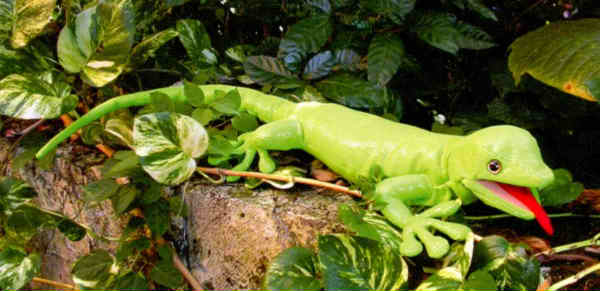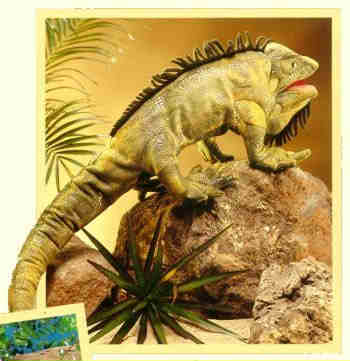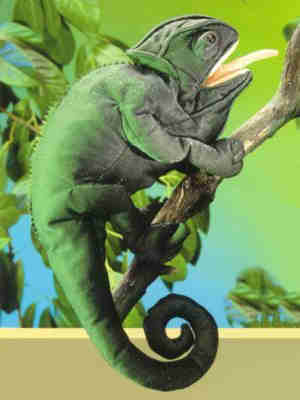|
|
Lizards are found everywhere on earth except the very north
of North America, the Arctic and Antarctica.
The largest lizard is the Komodo Dragon, which can reach up
to ten feet in length and weigh in at three hundred pounds.
The largest lizard family is the Skinks, which has one
thousand three hundred different species found all over the
world.
Like snakes, lizards have a Jacobsen's organ, and they smell
by "tasting" the air. When lizards flutter the underside of
their throats they are moving air past the Jacobsen's organ.
The best climber is the Gecko lizard, claws down. This
lizard has climbing pads on the bottoms of its feet. The
pads use friction to cling to surfaces by microscopic hairs.
Their claws grab surface irregularities to help the gecko
climb walls, ceilings, and even glass.
Many lizards (but not monitors or chameleons) can undergo
tail autonomy; in other words, they can lose the tail to
distract or escape from a predator. The tail breaks at a
particular spot in a vertebra. Then the tail that is left
behind wriggles, confusing the other animal. This defense
gives the lizard time to escape. It will grow back, but
without bone (just a rod of cartilage), and will be slimmer,
shorter and a different color, with small scales.
Some lizards have no legs! They look like their brother the
snake. Look closely, if it has movable eyes and ear
openings, it's a lizard.
The Gila monster (Heloderma sucpectum) and the Mexican
beaded lizard (Heloderma horridum) are the only two venomous
lizards.
Lizards shed their skin when they outgrow it. They shed in
little pieces, not all at once like snakes.
Lizards never stop growing!
Not all species of lizard lay eggs, some lizards give birth
to tiny replicas of themselves.
Lizards are cold-blooded. The cooler they are, the slower
they are.
Because of the above, lizards love to bask in the sun. But
this makes them sitting targets for their enemies.
Most lizards replace their teeth throughout life, with the
exception of the chameleon and the Agamid lizards.
Records for lizard longevity may be held by a Mexican beaded
lizard (33 years 11 months) and a Cayman Island ground
iguana (33 years 5 months).
Some skinks and geckos have eyelids. One example is the
Tokay Gecko. But like snake eyelids, they aren't movable;
the two lids have fused to form a clear "spectacle" which
sheds along with the rest of the skin.
Geckos have vocal cords which allow them to make sounds,
sometimes very loudly. They are the only known lizard
species that can make sound.
Really Neat Stuffed Geckos (click this link 4 all stuffed lizards
which are shown on this page, plus many, many more for you to select from)

Horned Lizards or American Horned Toads squirt blood from
their eyes to repel predators. Muscles in the head constrict
and stop the blood from flowing out of the head, so blood
pressure builds in the head until vessels in the inner
corner of the eyes rupture and squirt blood up to four feet.
The "third eye" seen on the top of the heads of some lizards
such as the Green Iguana does have a lens and retina-like
structure that connects through nerves to the pineal gland
in the brain. It does not form images but it is light-
sensitive, and governs hormone production related to time
spent basking.
Stuffed Iguanas

Herbivorous lizards conserve water in their bodies by
excreting excess salt from their blood streams through a
"salt gland" in their nasal passages. This is what produces
the crusty white stuff often sneezed out by iguanas.
The Basilisk and the Collared Lizard (Crotaphytus collaris)
can run on their hind legs. When they are young, they can
even run on water.
The Basilisk lizard is also interesting in another area. It
will sleep at the far end of small branches that hang out
over a pond or lake in the rainforest, and if a snake
slithers up the branch to try to eat it, the snake's
movement will usually shake the lizard off the branch, and
into the water and safety.
The Flying Draco Lizards of India glide between trees using
membranes linking their front and rear legs, similar to the
"wings" of the Flying Squirrel. They come down to the ground
only during mating season and to lay their eggs.
The
Chameleon has pigment-filled cells in its skin that
expand and contract according to the colors around them, as
well as to whether they are afraid, angry or in pain. They
even change color when they are sleeping, so if the light
changes around them, their color will change accordingly to
keep them camouflaged.
Stuffed Chameleons

Lizard Calendars
|